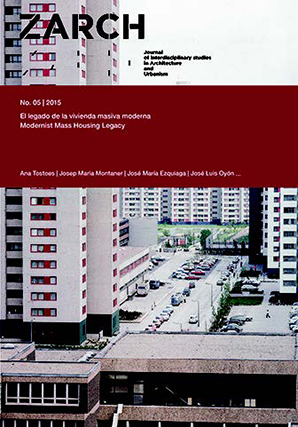The Quarto Cagnino District in Milan (1964-1973): Rationalist Figuration for a New Dimension of the Urban Space
DOI:
https://doi.org/10.26754/ojs_zarch/zarch.201559107Palabras clave:
Social housing districts, Milan, outskirt, dwellings architectural design, modernist architecture, Quarto CagninoResumen
The Quarto Cagnino district, like other Milanese social housing settlements, has a distinctly marked identity and, as with any other archi- tectural work, its framework calls for formulating a well-founded judgement based on the understanding of its context and the reasons that led the designers towards specific choices in form. The district designed for 1100 dwellings (approximately 5000 inhabitants) was built in two distinct phases between 1964 and 1973. Regarding the settlement plan, the Quarto Cagnino appears as a largely scaled construction organised into one main building, to which are connected four aligned buildings, perpendicular to the main body and alternately placed on either side. Quarto Cagnino faces with the problem of the integration of the dwellings providing an adequate amount of services, of which the scarcity had been one of the deficiencies of large popular districts. The image of the large dam, referring also explicitly to the theme of city walls, was associated with the idea of a constant permeability. The stereometric and Cartesian volumes of the buildings are built upon a powerful base of reinforced concrete that seems to lift itself from the ground thanks to a grid of cylindrical pillars. The open plan of the ground floor is an obvious reference to Le Corbusier and his Unité d’habitation quoted almost literally. The open ground floor enables se- condary roads to be drawn underneath the buildings, emphasizing the image of the great structure that connects with communication ne- tworks and guarantees a good development of service activities: some to the scale of the district such as primary and secondary schools, gymnasiums and the church, others to the scale of the building itself such as common spaces in which to gather.
Descargas
Referencias
ACOCELLA, ALFONSO: Architettura contemporanea Italiana. Gli anni Settanta. Firenze: A-linea 1981.
BAFFA, MATILDE; MONTALDO, VINCENZO; TUTINO, SANDRO: “Quartiere Gescal di Quarto Cagnino”, in L’Architettura Cronache e Storia. N° 248. June 1976. Milano: Etas.
LE CORBUSIER: Precisazioni sullo stato attuale dell’Architettura e dell’Urbanistica. Tentori, Francesco (ed). Roma-Bari, Laterza 1979.
LUCCHINI, MARCO: “Quarto Cagnino”, in Pugliese, Raffaele (Ed.): La casa Popolare in Lombardia 1903-2003. Milano: Unicopli, 2003.
NEPOTE, CRISTINA; ROSSARI, AUGUSTO: Ugo Rivolta disegni e costruzioni. Boves (Italy), ArabaFenice, 2008.
PICCINATO, GIORGIO; QUILICI, VIERI; TAFURI, MANFREDO: La Città Territorio. Verso una nuova grande dimensione, in Casabella, december 1962. N° 270, Milano: Domus.
PROTASONI, SARA: Casa “A” ad alloggi duplex e insulae nel quartiere di via Dessiè a Milano, 1951-55, in Gregotti, Vittorio, Marzari, Giovanni (Ed.): Luigi Figini Gino Pollini. Opera completa. Milano: Electa, 1996.
STROPPA, CLAUDIO: Quartieri urbani e crisi della città. Quarto Cagnino anno zero. Milano: Franco Angeli, 1975.
TAFURI, MANFREDO: Diga insicura. Sub Tegmine Fagi, in Domus, may 1981. N° 617. Milano: Editoriale Domus.
TAFURI, MANFREDO: Storia dell’Architettura italiana 1944-1985. Torino: Einaudi, 1982.





